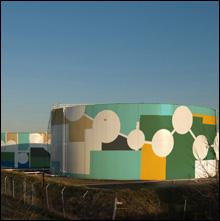My first thought when I learned about the project to paint 16 of the tanks in the big South Portland tank farm was “Why would anyone think this is a good idea?” I try to not prejudge any art project, and so went to get a look at the five semifinalist proposals and to hear about the project from Jean Maginnis, who conceived the project and has been the driving force behind its organization and its realization so far.
Maginnis talked to the Portland Phoenix at length about her grand vision of the cultural and economic impact the project could have for Maine artists, businesses and everybody else.
Having been steeped in the “creative economy” for much of my adult life, I found most of these assertions naïve, if not tendentious. (Also see “It’s Not About the Art,” by Jeff Inglis.)
And while hers is a new idea in terms of raw acreage — 261,000 square feet of steel oil-tank walls and roofs — my chief concern is what artistic fruit Maginnis’s mighty labors have brought forth.
Maginnis seemed reluctant to show the Phoenix images of the semifinalists’ designs without first presenting her PowerPoint slides on the creative economy, and showing the texts that the artists had prepared to explain what they were about. I felt as if, having decided to look at a show at the museum, I was required to read the wall texts before being allowed to view the paintings.
When I learned more about the project’s logistics, Maginnis’s insistence on giving the texts priority made more sense. That’s how the committee that selected the semifinalists had done their work. The project kicked off with a widespread call for initial proposals, made mostly through listings and arts organizations. That attracted more than 500 responses, not a large number considering the number of artists in America. Granted, it does require an especially outsized ego to think you can do something so big that thousands of passersby will see it involuntarily, but grand egos are not in short supply in the art business.
From this overwhelming flood of initial written responses, the selection committee, made up of artists from Maine and around the world (and a representative of Sprague Energy), had to weed out the semifinalists, a process that ensures that those artists who could make a good verbal case for their ideas would have an advantage. Artists who can write about how their ideas relate to the setting, history, demographic, or geographic nature of the site would logically rise to the top of the pile. Art that is “about” something is easier to justify to the general population than art for its own sake. But that doesn’t mean the best-written proposals are describing anything with intrinsic artistic value.

MUSICAL NOTATION: Collaboration with
Sara Lambert Bloom and Bo Nathan
Newsome. |
I’m not sure how anyone could expect to sort through that many proposals and come up with anything meaningful — the dozens of silly, unfortunate percent-for-art pieces dotting the landscape are mute testimony to the emptiness of that brand of thinking. Asking myself why anyone with real experience would consider judging a contest under these conditions, the only answer that occurred to me is that it would look good on the resume.That said, we are where we are with the process, and here’s what I could glean.
The proposals